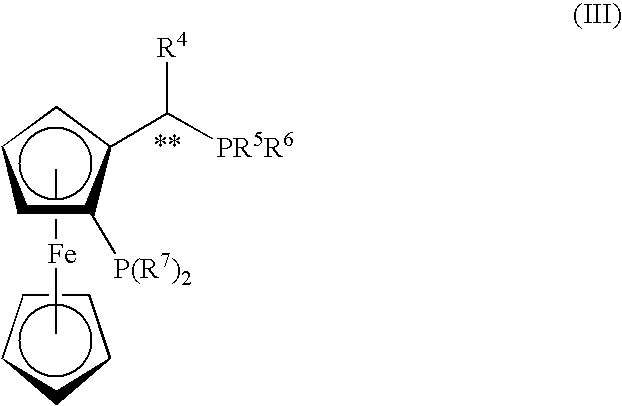Process For The Preparation Of Enantiomerically Enriched Beta Amino Acid Derivatives
a technology of enantiomerization and amino acid derivatives, which is applied in the preparation of amino-carboxyl compounds, chemistry apparatus and processes, organic chemistry, etc., can solve the problems of difficult synthesis of protected substrates
- Summary
- Abstract
- Description
- Claims
- Application Information
AI Technical Summary
Benefits of technology
Problems solved by technology
Method used
Image
Examples
example 1
[0175]
(2R)-4-oxo-4-[3-(trifluoromethyl)-5,6-dihydro[1,2,4]triazolo[4,3-a]pyrazin-7(8H)-yl]-1-(2,4,5-trifluorophenyl)butan-2-amine (2-5)
Preparation of 3-(trifluoromethyl)-5,6,7,8-tetrahydro[1,2,4]triazolo[4,3-a]pyrazine, hydrochloride salt (1-4)
[0176]
Step A: Preparation of bishydrazide (1-1)
[0177] Hydrazine (20.1 g, 35 wt % in water, 0.22 mol) was mixed with 310 mL of acetonitrile. 31.5 g of ethyl trifluoroacetate (0.22 mol) was added over 60 min. The internal temperature was increased to 25° C. from 14° C. The resulting solution was aged at 22-25° C. for 60 min. The solution was cooled to 7° C. 17.9 g of 50 wt % aqueous NaOH (0.22 mol) and 25.3 g of chloroacetyl chloride (0.22 mol) were added simultaneously over 130 min at a temperature below 16° C. When the reaction was complete, the mixture was vacuum distilled to remove water and ethanol at 27-30° C. and under 26-27 in Hg vacuum. During the distillation, 720 mL of acetonitrile was added slowly to maintain constant volume (appr...
example 2
[0217]
(2R)-4-oxo-4-[3-(trifluoromethyl)-5,6-dihydro[1,2,4]triazolo[4,3-a]pyrazin-7(8H)-yl]-1-(2,4,5-trifluorophenyl)butan-2-amine (2-5)
[0218]
[0219] Into a flask were charged bis(norbornadiene)rhodium(I) tetrafluoroborate {[Rh(nbd)2]BF4} (41.55 mg, 0.1 mmol), Ligand D (69.73 mg, 0.1 mmol) and the enamine amide 2-4 (45 g, 111.1 mmol) under a nitrogen atmosphere. To this mixture a solvent mixture of 37.5 mL methanol (extra dry and degassed) and 112.5 mL 2,2,2-trifluoroethanol (distilled and degassed) were added. The slurry was then transferred under nitrogen into an stainless steel autoclave and sealed. The autoclave was then heated to 50° C. and pressurized to 500 psig with hydrogen. A sample taken after 17 hours was analyzed using HPLC, which confirmed the end of the reaction giving 94% assay yield and 94% ee.
examples 3-5
[0220]
TABLE 1aEx.LigandMetal precursor% yieldb% eecconfig.3A[Rh(cod)2]BF47788R4B[Rh(cod)Cl]25876R5C[Rh(cod)CI]21578S
aReaction conditions: in TFE, 5 mol % metal precursor, 5 mol % ligand, 90 psig H2, 50° C., 18 h;
bAssayed by HPLC;
cAssayed by chiral HPLC using a AS-RH chiral column eluting with 20% acetonitrile / water as the mobile phase.
PUM
| Property | Measurement | Unit |
|---|---|---|
| Enantiomer | aaaaa | aaaaa |
Abstract
Description
Claims
Application Information
 Login to View More
Login to View More - R&D
- Intellectual Property
- Life Sciences
- Materials
- Tech Scout
- Unparalleled Data Quality
- Higher Quality Content
- 60% Fewer Hallucinations
Browse by: Latest US Patents, China's latest patents, Technical Efficacy Thesaurus, Application Domain, Technology Topic, Popular Technical Reports.
© 2025 PatSnap. All rights reserved.Legal|Privacy policy|Modern Slavery Act Transparency Statement|Sitemap|About US| Contact US: help@patsnap.com



